This post may contain affiliate links. Please read our disclosure policy.
Chinese Eggplant with Garlic Sauce is one of my favorite homestyle dishes growing up in Taiwan. My grandma was from Sichuan, so the flavors were bold—savory, tangy, and full of garlic. Over time, we made it more family-friendly at home—less spicy, but still packed with flavor.
This version is practical for home cooks, made in one pan, and full of tips to avoid mushy or oily eggplant. It’s authentic, comforting, and easy to make any night of the week.
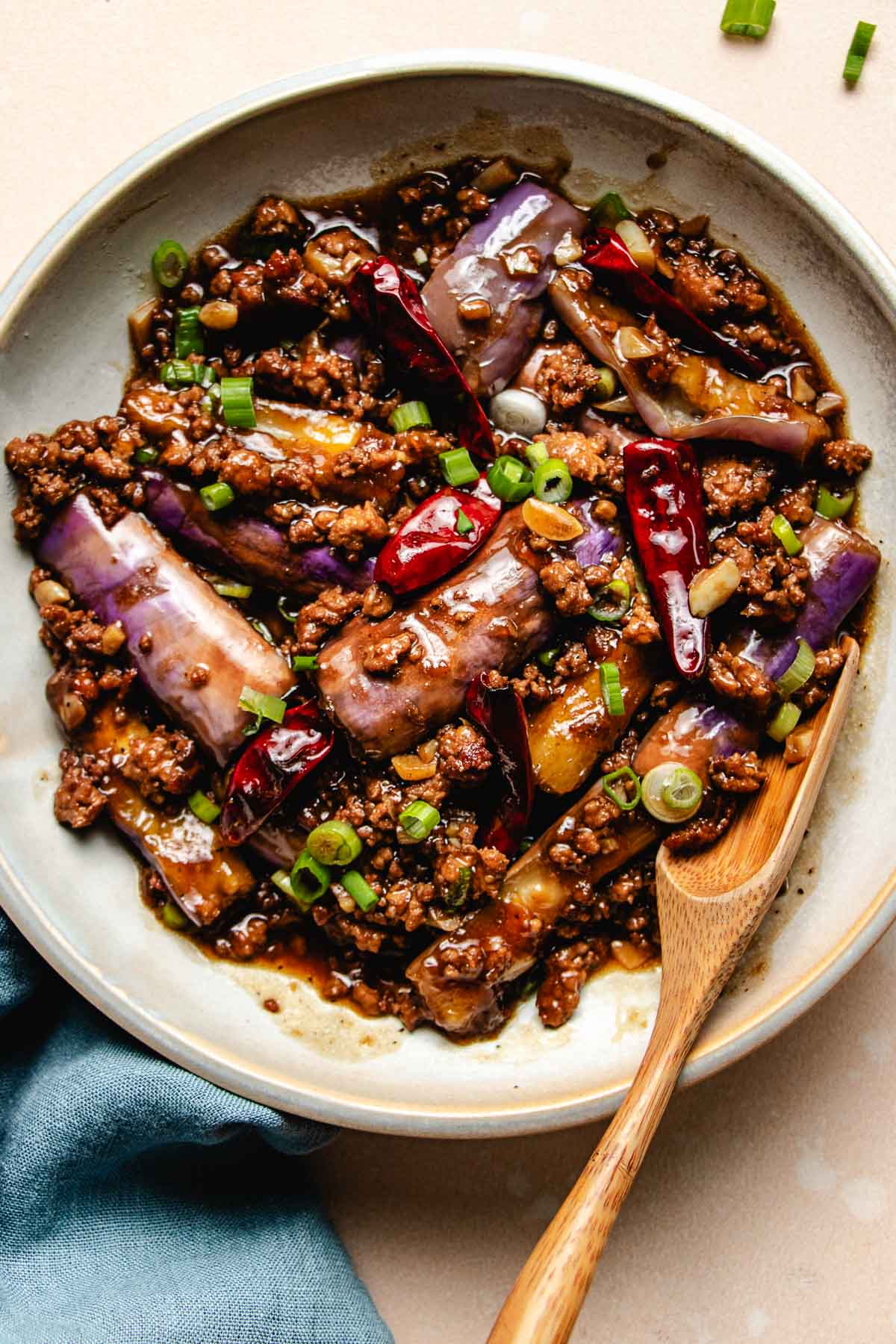
Main ingredient notes
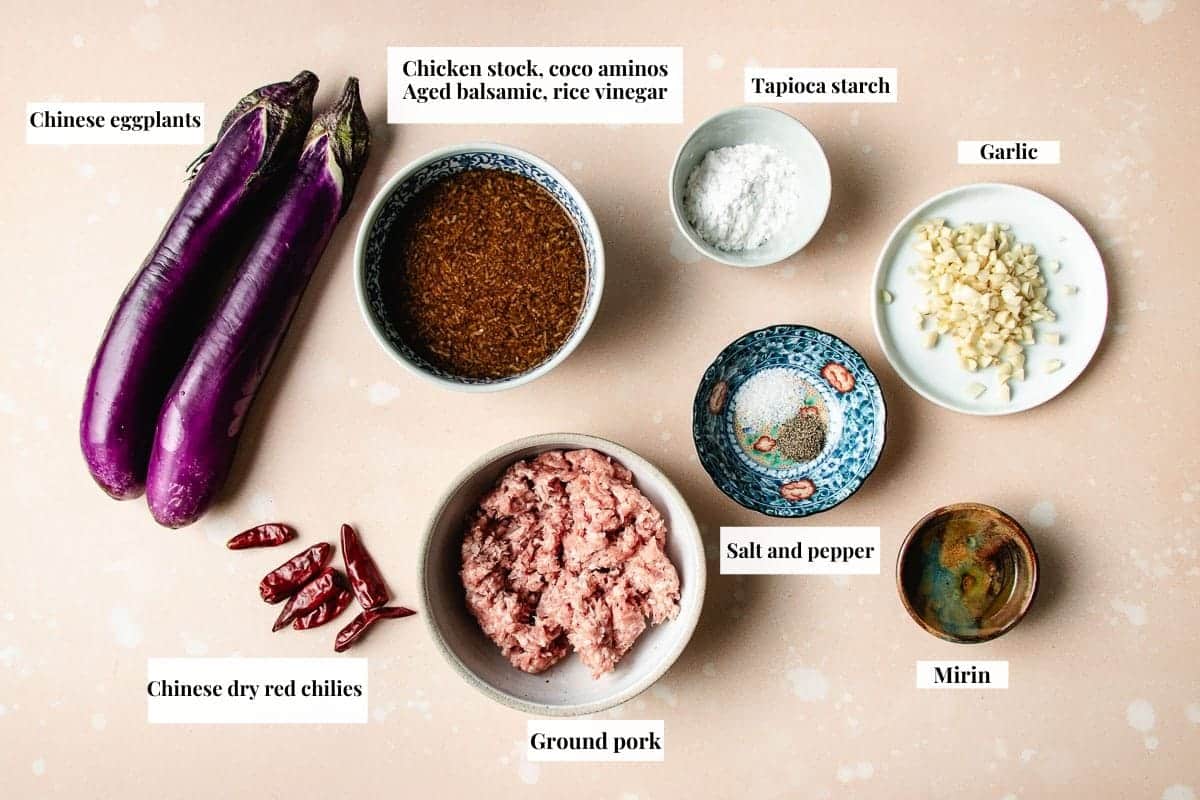
- Chinese Eggplant: These are long, slender, and naturally sweeter than globe eggplants. Their thin skin turns tender when cooked—no peeling needed. Choose ones that are smooth, shiny, and bright purple. Wrinkled or dull skin means they’re past their prime, which often leads to soggy or bitter results.
- Tapioca Starch: Lightly coating the eggplant with starch before pan-frying gives the surface a gentle crisp while protecting the inside from turning mushy. It also helps the sauce cling better without needing a heavy glaze.
- Chinese Dry Red Chilies + Garlic: Whole dried chilies infuse the oil with aroma without making the dish too spicy. Combined with plenty of fresh garlic, they form the base of that signature savory-tangy flavor.
- Ground Pork: This adds richness and umami to the dish. You can also use ground chicken (at least 50% dark meat), turkey, or beef. Or skip it entirely and use tofu puffs for a meatless version like my Eggplant tofu with basil sauce.
- Garlic Sauce: The sauce is savory, tangy, and lightly sweet—made with soy sauce, chicken stock, rice vinegar, and Chinese black vinegar. If you can’t find black vinegar, aged balsamic (thick consistency) is the closest match. Avoid regular balsamic—it’s too acidic and doesn’t mimic the depth of Chinese black vinegar.
How to make Chinese eggplant with garlic sauce
- Cut the eggplants into even pieces so they cook at the same speed
Slice off the tip ends, rinse, and pat dry. Then cut crosswise into 2.5-inch sections and quarter each one lengthwise. Keeping the pieces the same size is key—uneven cuts lead to overcooked or undercooked bites. - Soak the eggplant in vinegar water to keep it vibrant and less oily
Submerge the eggplant in a bowl of tap water with vinegar for 10 minutes. This quick soak helps preserve that pretty purple color and reduces how much oil the eggplant will absorb. Pat them dry well before tossing with starch.
TIP: If your slices are still wet, the starch won’t stick well—use a clean towel or paper towels to dry them thoroughly.
- Prep the garlic, chilies, and sauce so everything’s ready before you cook
Things move fast once the pan heats up. Mince the garlic, set aside the dried chilies, and stir the sauce together in a measuring cup so you can pour it in all at once later.
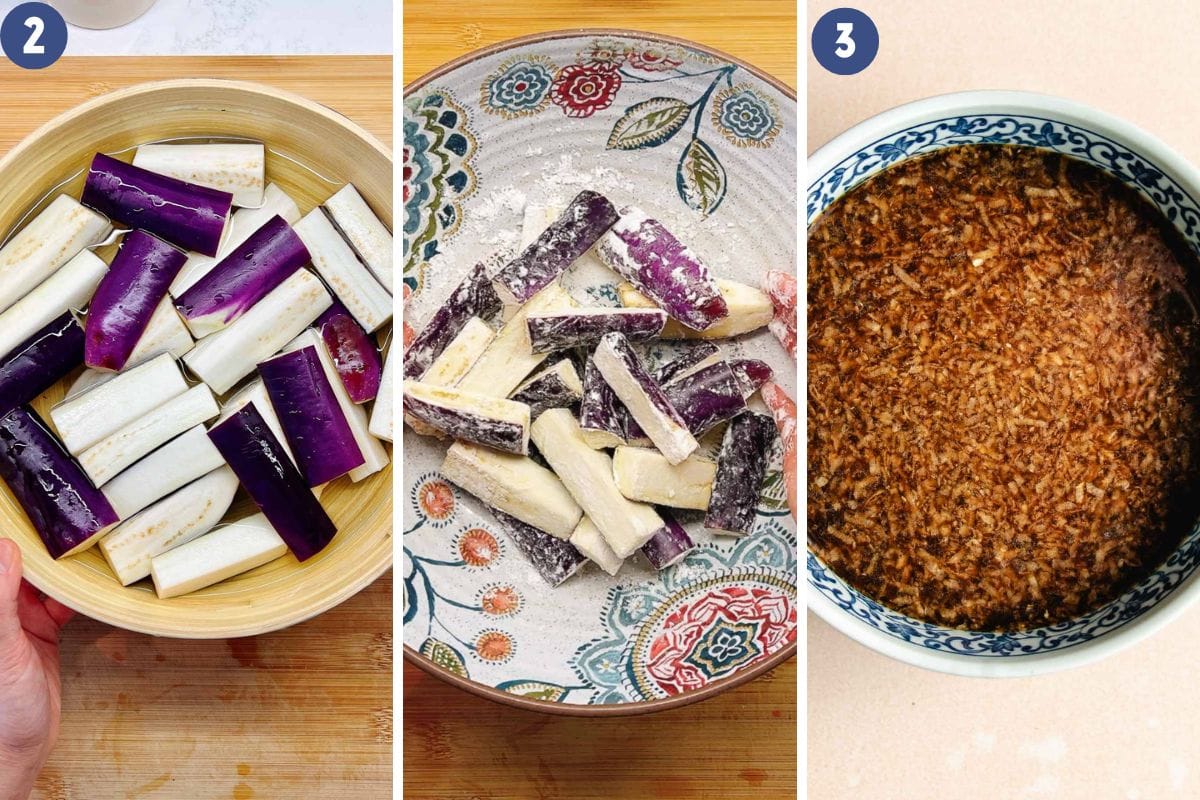
- Brown the meat first so it builds flavor into the pan
Heat 1 tablespoon of oil in a large non-stick pan. Add the pork and cook until browned and fully cooked, breaking it up into fine bits—about 5 minutes. Season it, then stir in the garlic and chilies for one more minute to release their aroma. - Cook the eggplant in a hot pan so it sears, not steams
Push the meat to the side and add the eggplant and remaining oil. Season with a little more salt and fry over medium-high heat for 3 minutes. Make sure the pan is large enough (12 inches is ideal) so the eggplant has room to cook evenly.
TIP: If the pan is too crowded, the eggplant will steam and turn soggy instead of caramelizing.
- Simmer everything in garlic sauce until the eggplant is buttery-tender
Pour in the sauce and gently press the eggplant down so it touches the liquid. Cover and simmer on medium heat for 3 to 4 minutes, stirring every couple of minutes until the eggplant is soft but not mushy. You should be able to pierce it easily with a chopstick.
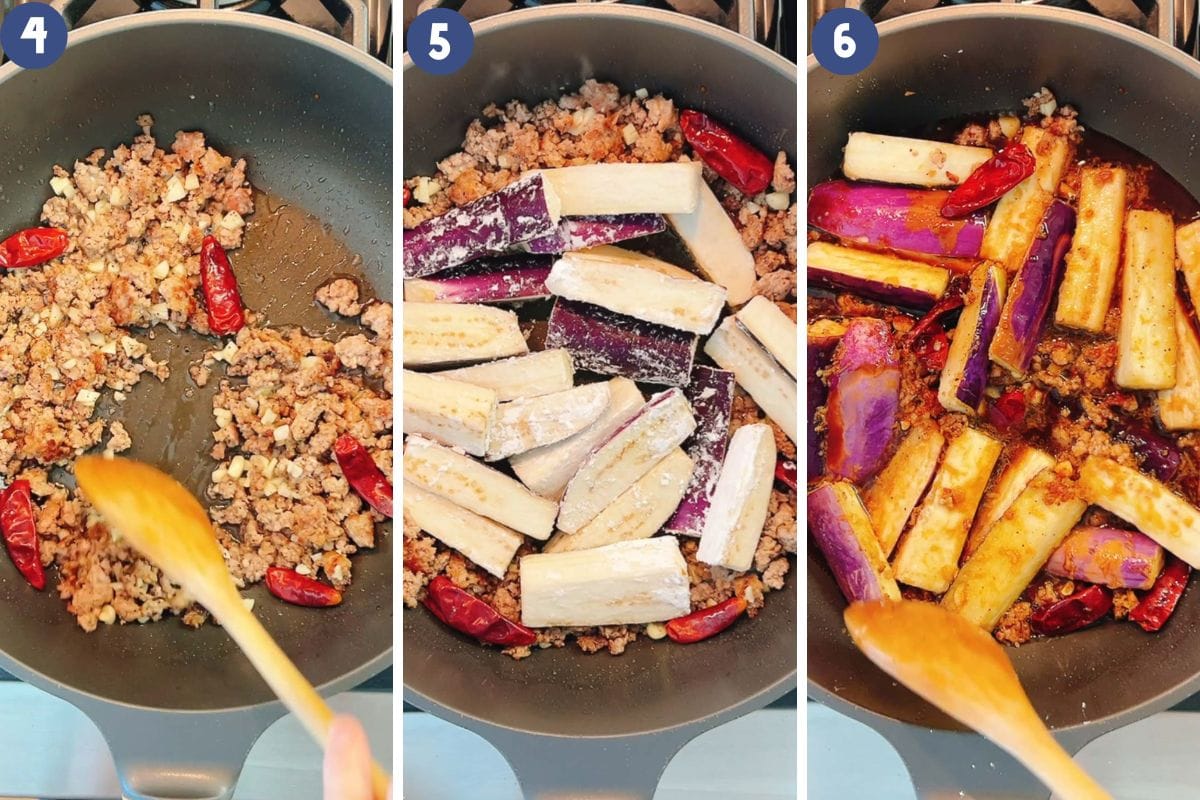
- Garnish and serve warm with rice
Turn off the heat and transfer everything to a serving bowl. Top with scallions and serve right away with steamed rice. The sauce soaks in fast, so it’s best enjoyed hot.
What to serve with garlic eggplant
This savory eggplant stir fry dish is hearty enough to stand on its own, but it’s even better with a few sides to round out the meal. Here are some of our favorite ways to serve it family-style.
- Vegetable sides: Cool things down with a crisp Chinese smashed cucumber salad or add crunch with garlicky Chinese green beans. For a warm option, try stir-fried Chinese broccoli or a simple sautéed napa cabbage.
- Rice or noodle dishes: Soak up that flavorful garlic sauce with rice cooker white rice, or pair it with shrimp-studded Din Tai Fung fried rice. For something with a little more texture, Cantonese chow mein brings just the right contrast.
ChihYu’s helpful tips
- No need to peel. Chinese eggplant skin is thin and softens as it cooks—plus it adds nutrients and color, so leave it on.
- Use a non-stick pan and cook gently. Stir carefully so the eggplant doesn’t stick or break apart, especially once it softens.
- Don’t overcook. Eggplant turns mushy quickly. It’s ready when you can poke through it easily with a chopstick.
- Give it space. Use a 12-inch pan to keep the eggplant from steaming. Crowded pans lead to uneven, soggy results.
FAQs
That usually happens when the eggplant isn’t soaked first, or when it’s overripe. A quick vinegar-water soak helps preserve its vibrant purple color and slows oxidation during cooking. Also, make sure to choose fresh, firm eggplants with smooth, bright skin—dull or wrinkled eggplants tend to discolor more easily.
The sauce should naturally reduce as it simmers, but if you want it thicker, mix 2 teaspoons of starch with 2 tablespoons of cold water and stir it in during the last minute of cooking.
Try these Chinese eggplant recipes next!
If you loved this stir fried garlic sauce eggplant, here are a few more reader favorites to explore—all with different flavors and cooking methods.
- Air Fryer Chinese Eggplant – Crisp on the outside, tender inside, and tossed in a simple garlicky soy glaze.
- Roasted Chinese Eggplant – A hands-off sheet pan version with nutty tahini sauce and bold umami flavor.
- Thai Basil Eggplant – Stir-fried with aromatic Thai basil and a savory-spicy sauce, this one’s packed with personality.
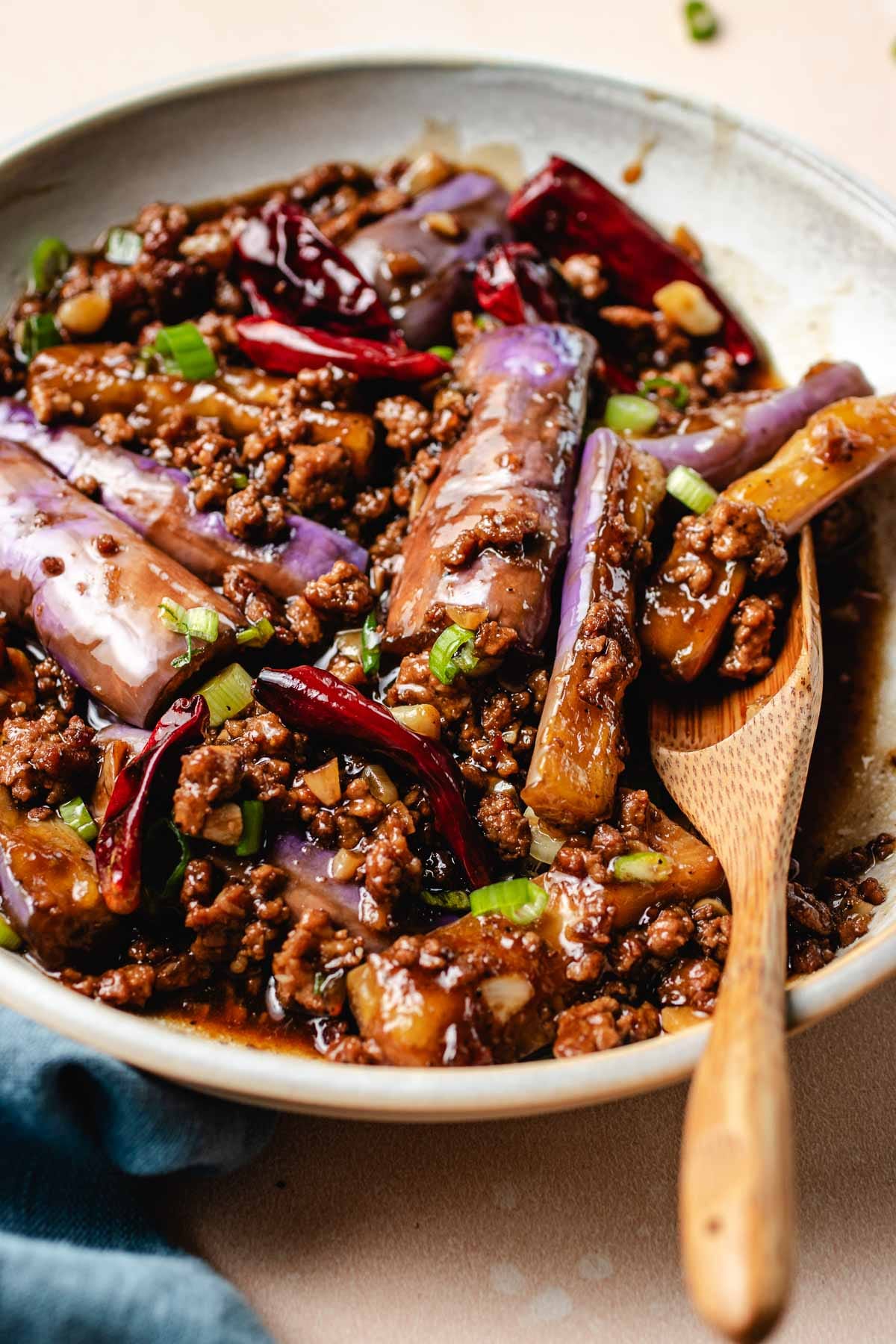
Chinese eggplant with garlic sauce recipe
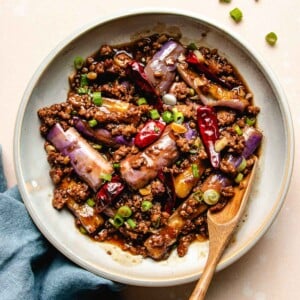
Video
Ingredients
For the eggplants:
- 1 lb Chinese eggplants 2 long eggplants
- 3 cups water optional
- 3 tbsp white vinegar optional
- 2-2.5 tbsp tapioca starch optional
For the ground meat:
- 3 tbsp avocado oil divided
- 0.5 lb ground pork
- 1/2 tsp coarse sea salt
- ¼ tsp ground black pepper
- 1 tbsp Chinese cooking wine
- 0.8 oz garlic cloves finely minced, 5 large
- 5 whole Chinese dry red chili peppers
- 2 bulb spring onions diced
For the garlic sauce:
- 1 cup chicken stock
- 2 tbsp soy sauce
- 2 tsp sugar or more to taste
- 1 tbsp Chinese black vinegar or more to taste
- 2 tbsp rice vinegar
- 0.5 oz garlic clove grated, 3 large
Instructions
Prepare Chinese eggplants:
- Slice off the tip ends of the eggplants. Rinse and pat dry. Slice the eggplant crosswise into 2.5-inch sections then quarter each section lengthwise.
- Soaking: In a large bowl, add the eggplants and fill the bowl with tap water. Place a plate up-side-down on top of the eggplants to help them submerge under the water. Soak for 10 minutes. After soaking, pat them dry and toss them with starch.
Aromatics and Garlic sauce:
- In the meantime, prepare the garlic, set aside red chilies, and combine the garlic sauce in a measuring cup.
Cook the ground meat:
- In a well-heated large non-stick saute pan, add 1 tbsp oil, fry the meat over medium-high heat until it’s cooked through and break up to fine pieces, about 5 minutes. Season with salt, pepper, and cooking wine, and add-in the garlic and dry chilies. Fry the ground meat for 1 more minute.
Fry the eggplant:
- Push the meat to the side of the pan, add the eggplants and the remaining 2 tbsp oil, and season with another pinch of salt. Fry the eggplants over medium-high heat for 3 minutes.
Add the garlic sauce:
- Pour in the garlic sauce. Gently push the eggplants down to touch the liquid. Cover with a lid. Lower the heat to medium and simmer for 3-4 minutes until the eggplants are soft and cooked through, stirring every 2 minutes. Turn off the meat.
Serving:
- Transfer them to a large serving bowl and garnish with scallions. Serve warm with a bowl of steamed rice.
Notes
- Why soak the eggplants? Soaking in vinegar water helps reduce oil absorption and keeps their purple color vibrant.
- Selecting Chinese eggplants: Choose ones with smooth, shiny skin and no wrinkles or bruises. The color should be bright purple, and they should feel firm and slightly spongy to the touch.
- Different ground meat: You can also use ground chicken (at least 50% dark meat), turkey, or beef. The flavor will be slightly different but still delicious.
- Other eggplant types: If you’re using Italian or graffiti eggplants, the flavor will be a bit different. They’re less sweet and have more seeds. After slicing, salt them for 15 minutes to draw out bitterness, then pat them dry before cooking. There’s no need to rinse after salting. You might need to adjust the sauce by adding a touch more sugar.
- Gluten-free substitutes: Use gluten-free mirin as a 1:1 substitute for Chinese cooking wine. Chinese black vinegar is not gluten-free, so aged balsamic vinegar is the easiest swap. Aged balsamic has a deeper, more caramelized flavor and is sweeter, so you may not need to add extra sugar. Regular balsamic vinegar (not aged) is much more acidic and lacks the depth needed to mimic Chinese black vinegar—I don’t recommend using it as a substitute. Taste and adjust as needed.
- Make-ahead, storage, and reheating: This dish is best served fresh, but the garlic sauce can be made 1 to 3 days in advance and stored in the fridge. Leftovers will keep in an airtight container in the fridge for 3 to 4 days.
- Microwave: Reheat on medium power for 1.5 to 2 minutes, stirring halfway through.
- Stovetop: Reheat over medium-low to medium heat, stirring frequently with a wooden spoon.
Nutrition
Nutrition information is automatically calculated, so should only be used as an approximation.
Made a dish and loved it? Please rate the recipe and leave a comment in the section below! It helps my blog grow organically, allowing me to continue sharing free and awesome content with you. Thank you!
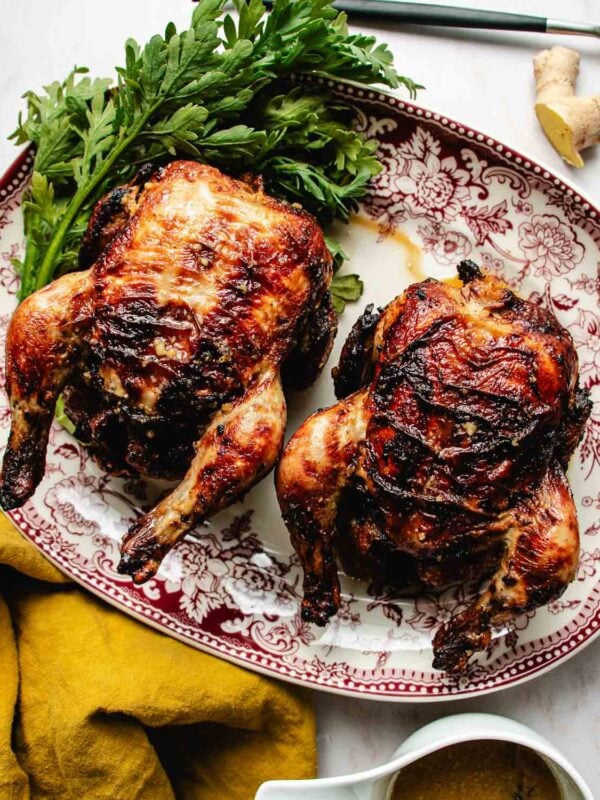
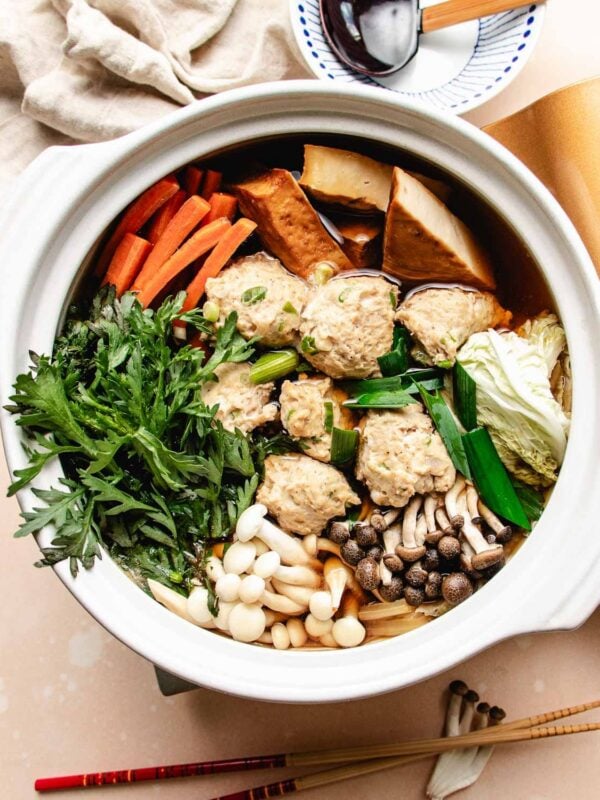
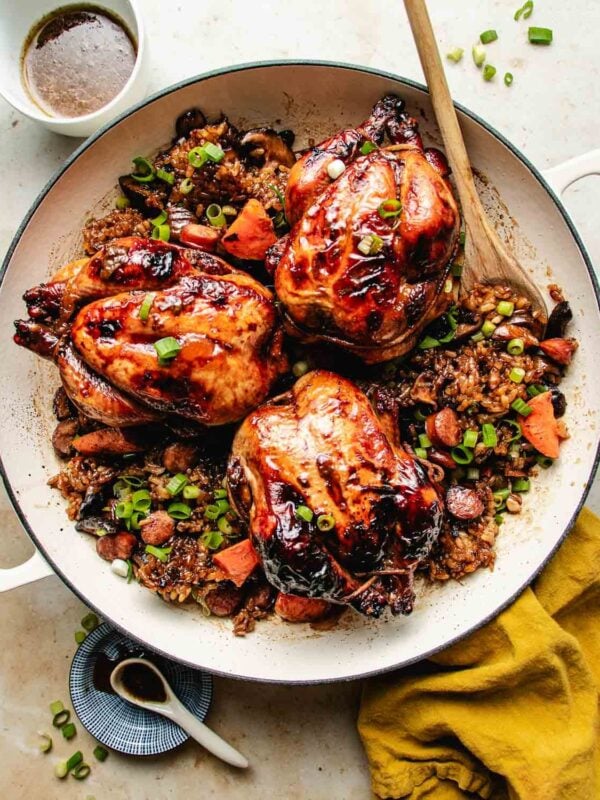
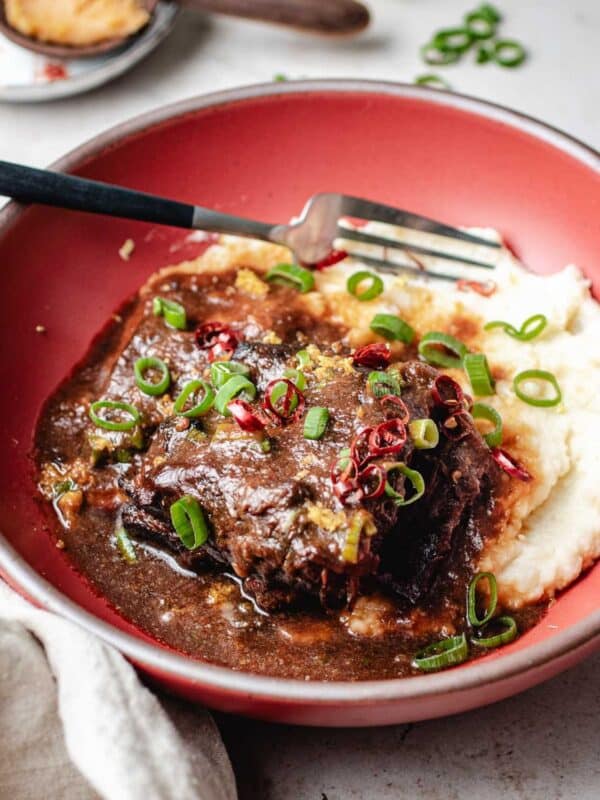









Phenomenal. Made it with the chow mein.
Wow! What a lovely spread you have!
This recipe is sooooo good. It taught me how to cook the eggplants in my garden properly. They were so soft and creamy and delicious. I can’t wait to try another eggplant recipe. Thanks for teaching me how to cook with eggplants!!!
Hi Karin, thank you so much. I’m so happy to hear. Thanks for coming back here and share your experience with us! 🙂
I tried this yesterday and it was so delicious. Due to my Hashimoto I had to switch my diet but ofc I was missing a lot of yummy Asian food. This dish was one of my favorites while I lived in China. I am so grateful for your blog. I have tried so many recipes – your AIP Kimchi recipe is one of my favorites, and I am just so happy to have found you. So just thank you for sharing your recipes and making me love cooking again.
Awww Yuzu, thanks so much for your kind words. I so appreciate you as well. Thanks again and very happy to have found you here, too!
SO TASTY! My favorite way to eat eggplant. The eggplant is so tender and flavorful and drinks up all the sauce. I love all of ChihYu’s recipes, so it’s not surprising that that this one is a winner. Delicious!!
So happy to hear. We absolutely love this dish, too!
We loved this recipe!
Thank you so much!
Love this easy and delicious recipe. I always double the sauce so it’s extra saucy!
Thank you so much!
This was my first time making an eggplant dish and Chihyu’s directions were detailed and helpful to help me navigate through the process. Dish came together quite easily! If you have a wok, I would definitely recommend that. I didn’t use it this time but would the next time I make it. I would also peel the skin next time as the skin of the eggplant was a bit tough.
Thanks so much!
I had to report back- this was AMAZING! So flavorful and the perfect texture. I used Apple Cider vinegar (less per your suggestion) and dried Thai chilis which is what I had on hand. YUM!
Do you think this would freeze well? I freeze a lot of food but have never frozen eggplant. Thanks so much!
Thanks for sharing, Holly! Hmm…I don’t know about freezing the eggplants after they are cooked. You can test with a small amount and see how it goes. My guess is that the eggplant texture will change – more mushy and maybe more watery as well.
Chihyu, I’m making this tomorrow and need to know the closest substitute for rice vinegar. What tastes the most similar? Thank you
You can also use apple cider vinegar in smaller amount. Apple cider tastes more sour than rice vinegar.